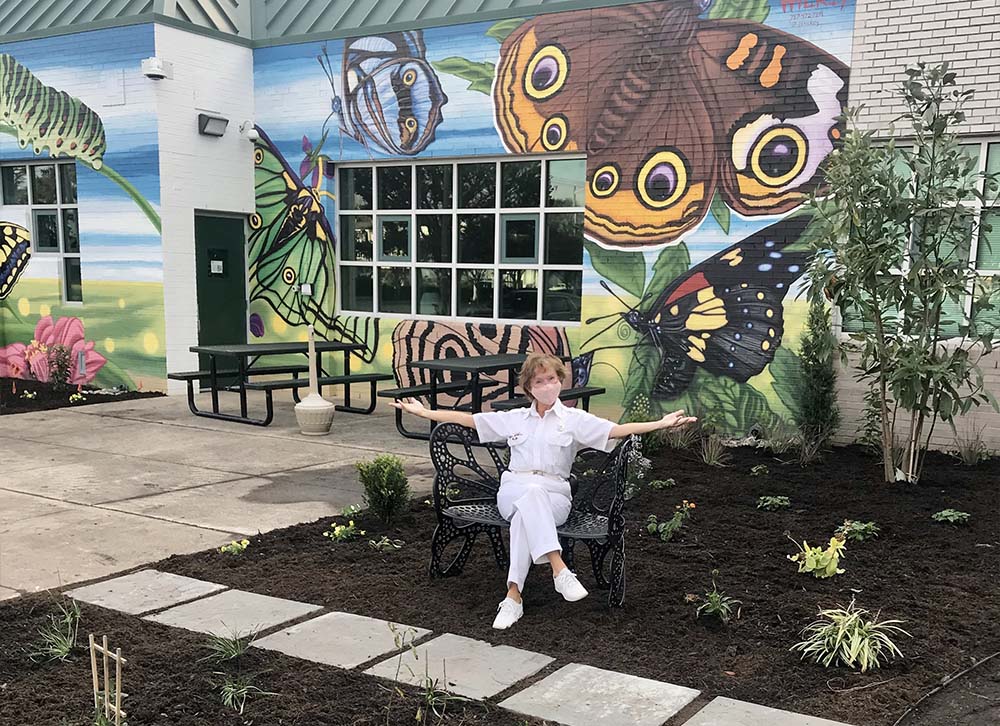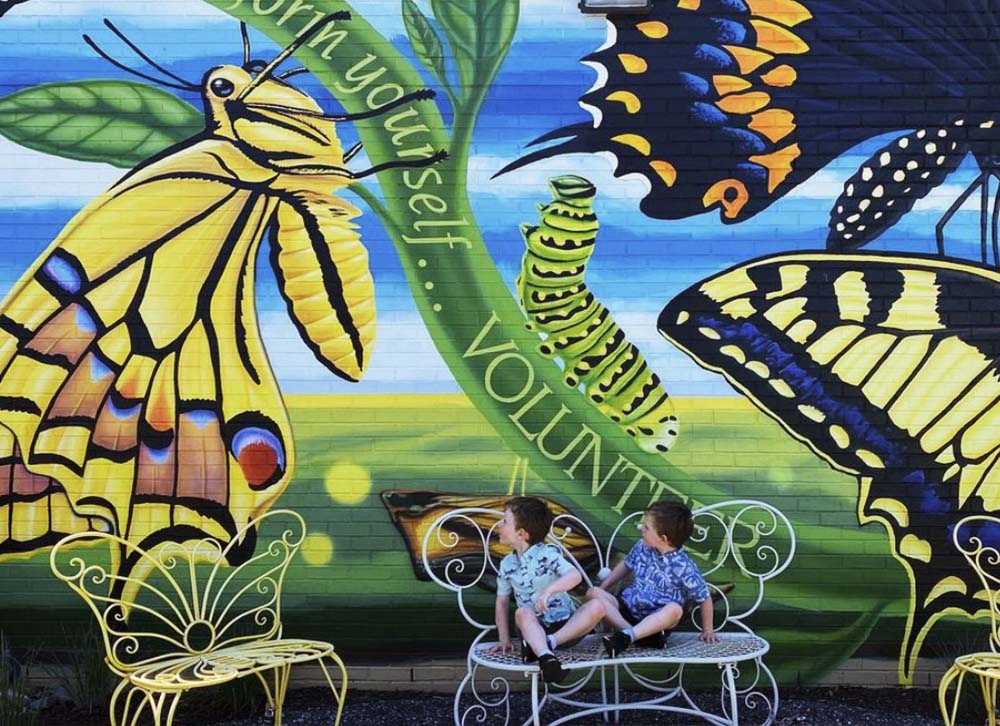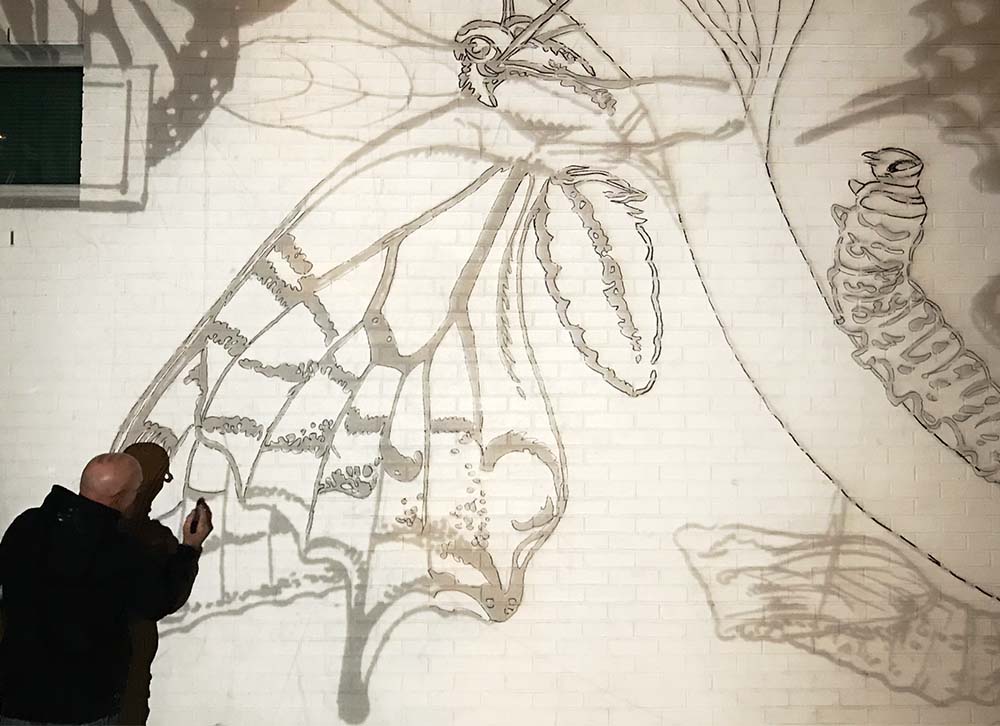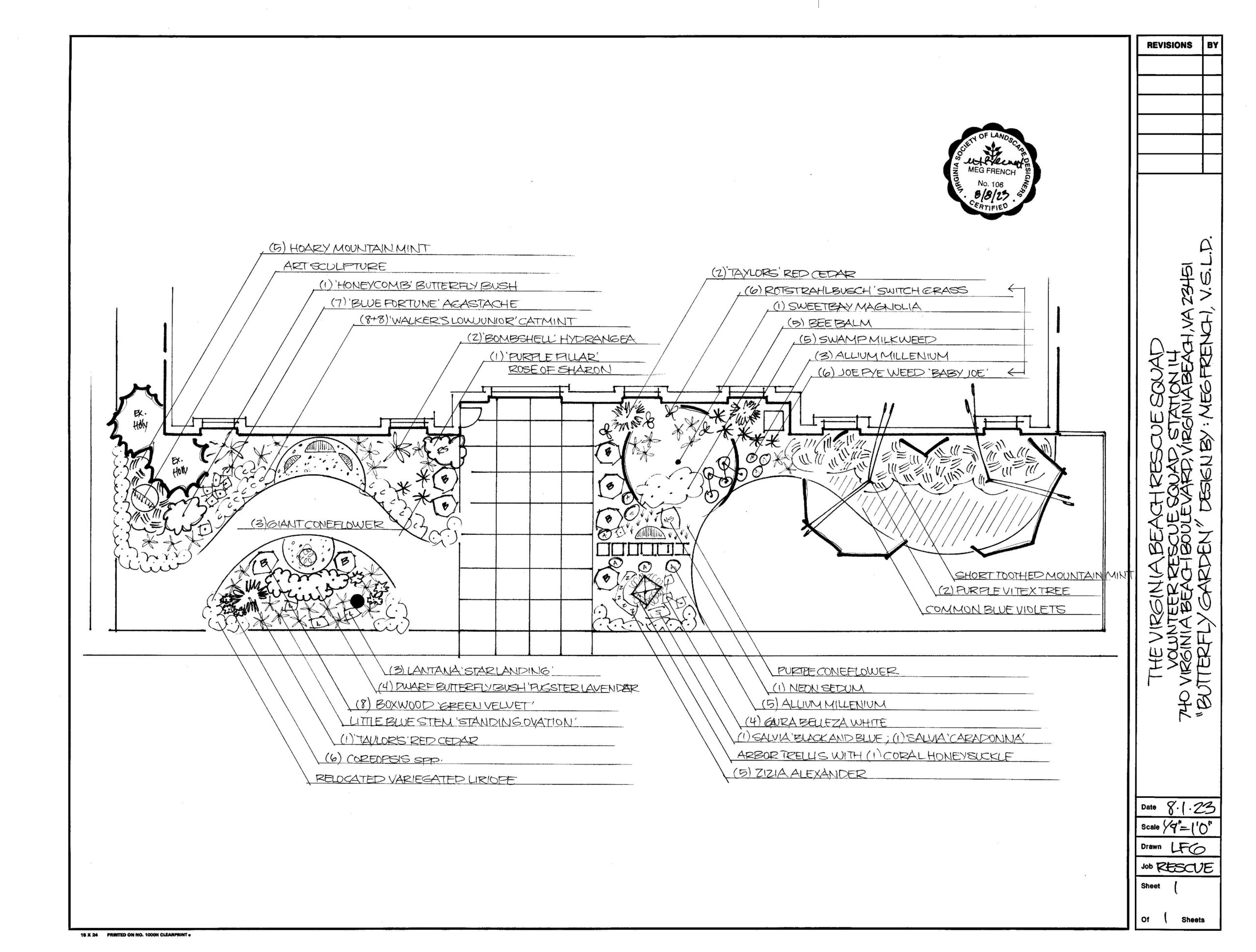Butterfly Mural and Garden
Transform Yourself and Volunteer

So many times we hear how our volunteers feel as if they have been transformed by the process of learning something new, giving back to our community, or simply the powerful feeling of being needed and appreciated.
We absolutely love the volunteers in our squad and those in our sister rescue squads in Virginia Beach that make up our very special EMS system.
We also love the symbolism of transforming into a beautiful butterfly, and that’s why the colorful mural on our oceanfront station celebrates this process. Even better, we’ve created a lovely pollinator garden to go with it.
Station 14 is close to the ViBe Creative District and is on the Walking Mural Tour map.
We deeply appreciate these donors who helped us create Color Your World, the VBVRS Butterfly Mural and Pollinator Garden:
Lead Donor
In Loving Memory of Mike Cohen
Key Donors
Cavalier Garden Club
Ron Foresta and Family
Home Depot Community Projects Fund
Virginia Beach Garden Club
Princess Anne Garden Club
Chuck Guthrie
Gentle Rain
askHRgreen.org
Gifts In Kind
City of Virginia Beach
Emily Mills
Ellen McBride
This Color Your World project is maintained by VBVRS volunteers. Donations for maintenance is appreciated! To help us, go to our Donate page and apply your gift to “Butterfly Garden” in the dropdown menu.

John Hickey, Our Mural Artist
John Hickey was born in Norfolk, Virginia and has been interested in art his whole life. He attended Norfolk Technical Vocational Center for commercial art and has an Associate degree in commercial art and illustration from The Art Institute of Philadelphia. He has worked in local advertising circles as an illustrator and art director, and now paints murals and signage for Hampton Roads businesses.
As a mural artist, John Hickey has been described as “renowned” and his murals as “iconic,” and VBVRS is so proud to have a mural created by him on Station 14, our oceanfront station.
“As I created this mural, I was inspired by the volunteer rescuers; they’re beautiful people much like butterflies. Through their giving hearts, they are transformed, inspiring others in our community.” – John Hickey

Meg French, Our Pollinator Garden Designer
Meg, a certified landscape designer with a degree in horticulture, owns Meg French Landscape Design. She is a Master Naturalist, a Member of The Virginia Society of Landscape Designers, and on the Horticulture Board for the Garden Club of Virginia. She has over 20 years of experience serving the Hampton Roads community.
Designing the new butterfly garden for the Virginia Beach Volunteer Rescue Squad was a wonderful pleasure for me to give back to the community as well as to work with VBVRS member Emily Mills on the exciting, beautiful and educational project. Our goal was to plan a well-designed butterfly garden, which would provide for and support butterflies so they could enjoy permanent residence in our garden, from egg, to chrysalis, to adult butterfly…repeat!
We chose flowering plants that were nectar rich and could provide overlapping seasons of continual blooming, providing nectar (a butterfly’s food source) from early spring through late fall. We also needed to provide specific “host plants” for the different species of butterflies to lay their eggs on. For example, a Monarch butterfly will lay her eggs on milkweed, whereas an Eastern Tiger Swallowtail will search for trees and shrubs such as chokecherry shrubs, black cherry trees, black willow trees or pussy willows.
Once the butterfly is pregnant, she flies around with her fertilized eggs looking for her particular host plant by visual and chemical cues. She then lays her eggs on the leaves (often on the underside of the leaf) and as the larvae grow, they will eat out of their shells and then will eat the leaves of the host plant it is on. The host plant’s leaves provide many nutrients and defense chemicals that each butterfly will need to protect itself, helping it grow and survive to its chrysalis stage, and then on to butterfly-hood!
VBVRS Butterfly Garden Design

Here are a few of the easy guidelines we followed as we developed the VBVRS butterfly garden:
- Plant a wide variety of nectar- and pollen-rich flowers in your garden that will provide a succession of blooms from early spring until fall.
- Lean heavily on choosing from a diverse selection of native plants. The butterflies have co-evolved with these natives and often look to them for specific needs, whether it’s for food or using it as its “host” plant for reproduction.
- Plant large groups of the same flower to increase pollination efficiency. This helps the butterflies and other pollinators to transfer pollen to other flowers of the same species instead of wasting the pollen on the flowers of unreceptive plants.
- Provide shelter in your garden. Pollinators need protection from predators and weather. Leave areas of your gardens that are “messy” to provide a safe place to shelter when needed.
- Create a water feature, pond, birdbath or puddling bowl that has sloped sides to ensure the pollinators can easily sip without drowning.
- Plant herbs and annuals that are good for pollinators such as fennel, parsley, lavender, chives and mint. Annuals such as zinnias, cosmos and sunflowers are also favorites.
Trees
- Sweetbay Magnolia (host and nectar)
- “Shoal’s Creek” Purple Vitex (nectar)
- “Taylor’s Red” Eastern Red Cedar (host)
Grasses
- “Shenandoah” Switch Grass (host and nectar)
- “Red October” Big Bluestem (host and nectar)
- “Standing Ovation” Little Bluestem (host and nectar)
Shrubs
- Wax Myrtle (host and nectar)
- Spicebush (host and nectar)
- “Honeycomb” Butterfly Bush (nectar)
- “Pugster Blue” Butterfly Bush (nectar)
- “Bombshell” PanicleHydrangea (nectar)
- Chokeberry (host and nectar)
- Rose of Sharon “Purple Pillar” (nectar)
Perennials
- “Miss Huff” Lantana (nectar)
- Pycnanthemum Virginianum (Common Mountain Mint) (host and nectar)
- Pycnanthumum muticum (Short Toothed Mountain Mint) (host and nectar)
- Agastache “Black Adder” (or Blue Fortune)(host and nectar)
- Echinacea “Magnus” (host and nectar)
- Echinacea pallida (host and nectar)
- “Walker’s Low Junior” Catmint (nectar)
- Rudbeckia maxima (host and nectar)
- Rudbeckia hirta (host and nectar)
- Rudbeckia fulgida var. fulgida (host and nectar)
- Rudbeckia laciniata (host and nectar)
- Eryngium Rattlesnake Master (host and nectar)
- “Millenium” Allium (nectar)
- “White Improved” Guara (host and nectar)
- “Little Joe” Joy Pye Weed (host and nectar)
- Zizzia (host and nectar)
- “Marshall’s Delight” Bee Balm (host and nectar)
- Aster cordifolius “Avondale” (host and nectar)
- Tickseed Coreopsis (host and nectar)
- Sedum “Neon” (nectar)
- Coreopsis “Cream and Red” (host and nectar)
- Coreopsis “Daybreak” (host and nectar)
- Nodding Onion (host and nectar)
- “Major Wheeler” Coral Honeysuckle (host and nectar)
- “Walker’s Low” Catmint (host and nectar)
- Beebalm “Fireball” (host and nectar)
- Swamp Milkweed (host and nectar)
- Lynnhaven Carpet (Erygeron) (host and nectar)
- Common Violets (host and nectar)
- Variegated Liriope (nectar)
Meg recommends these resources for pollinator information:
Websites
- pollinator.org
- ButterflySocietyOfVa.org
- vnps.org (The Virginia Native Plant Society)
- xerces.org
- BringingNatureHome.net
Books
- Pollinator-Friendly Gardening by Rhonda Hayes
- Gardening for Butterflies by The Xerces Society
- Attracting Native Pollinators by The Xerces Society
- The Bee-Friendly Garden by Kate Frey
- Pollinators of Native Plants by Heather Holm
- 100 Plants to Feed the Bees by The Xerces Society
We Volunteer, But Rescue Is Not Free.
Support The Virginia Beach Volunteer Rescue Squad.
Every dollar counts.
You can be the difference that allows us to have the life-saving equipment and supplies we need to answer every cry for help.
Honor someone you know.
Did you know that you can honor someone when you give us a donation?
Learn CPR. Absolutely free.
Did you know that 70% of all sudden cardiac arrests take place in the home? Now you know. Come learn what to do.
Join us. We need you.
Help us help others. And see what a difference it makes in your own life. Start the process by filling out the online application.
You like us. You really like us.
Share how a VBVRS crew rescued you! Tell us your story and we’ll tell you ours, keeping you up to date with all that our crews are doing.
